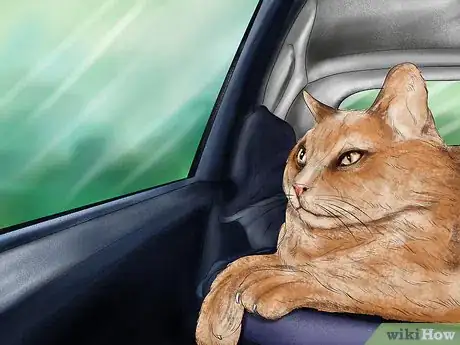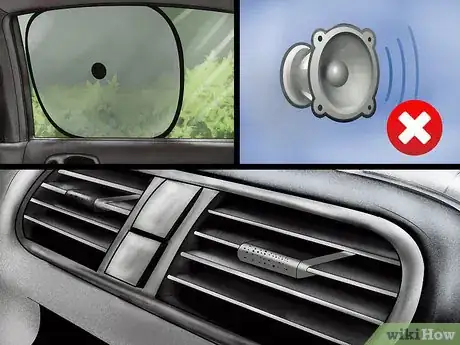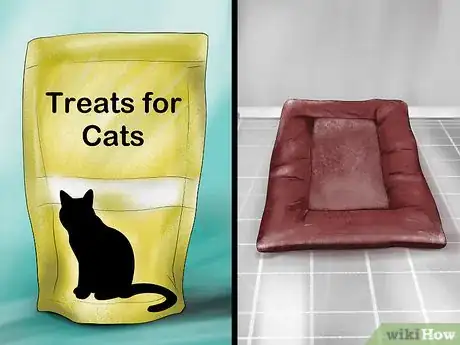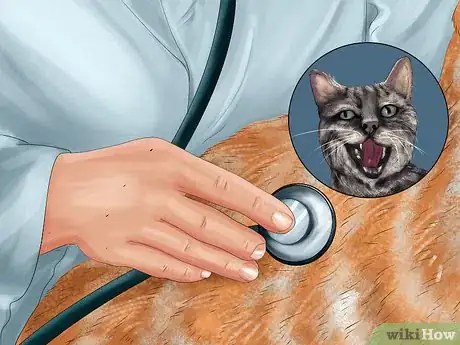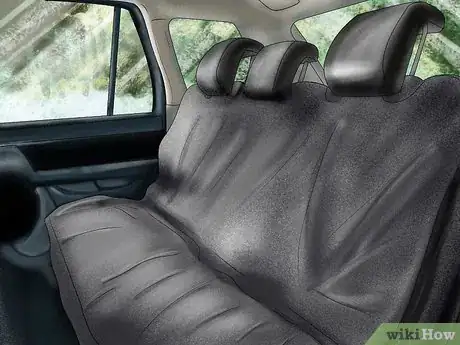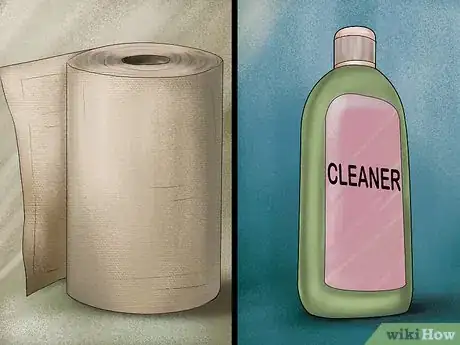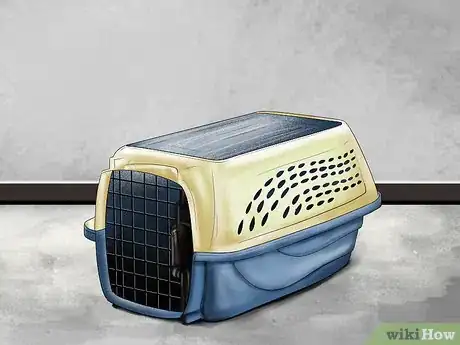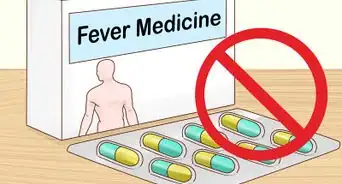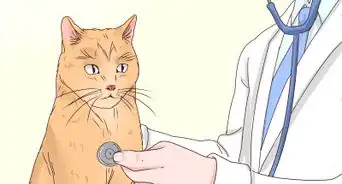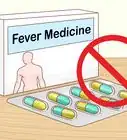This article was co-authored by Deanne Pawlisch, CVT, MA. Deanne Pawlisch is a Certified Veterinary Technician, who does corporate training for veterinary practices and has taught at the NAVTA-approved Veterinary Assistant Program at the Harper College in Illinois and in 2011 was elected to the board of the Veterinary Emergency and Critical Care Foundation. Deanne has been a Board Member of the Veterinary Emergency and Critical Care Foundation in San Antonio, Texas since 2011. She holds a BS in Anthropology from Loyola University and an MA in Anthropology from Northern Illinois University.
There are 7 references cited in this article, which can be found at the bottom of the page.
This article has been viewed 13,763 times.
Traveling with a cat is relatively easy because of their size and nature. However, some cats – especially those that are nervous or don’t get out of the house often – may experience car sickness. Car sickness can manifest in many ways but usually results in cats vomiting. However, by conditioning your cat to ride in cars, consulting your veterinarian, and making sure you’re ready to clean a mess, you’ll be better able to deal with car sickness in your cat.
Steps
Conditioning Your Cat to Riding in Cars
-
1Ensure safety for you and your cat. Safety is the most important thing to consider when traveling with your cat. This is especially true since your cat could interfere with your ability to drive. However, some safety measures can potentially create anxiety for your cat.
- If you use a harness or another device to secure your cat to the seat, make sure your cat is comfortable in it.
- Avoid bulky harnesses and other safety devices.
- Try equipping your cat with any safety equipment while at home. This way, it can get used to the feeling of a seatbelt harness while not in the car.
- Consider using a cat carrier to secure your cat. This way, your cat will be secured safely in an environment it is already familiar with.[1]
-
2Get your cat used to the cat carrier. If you are transporting your cat in a cat carrier, it’s important that your cat gets comfortable simply being in the carrier before moving the carrier to the car. Keep the carrier open and accessible in your home, so that your cat can come and go as it pleases. Make the carrier comfortable with bedding, toys, and treats to invite the cat inside.[2]
- Start feeding your cat in the carrier. If your cat won’t eat in the carrier initially, place the food bowl a little closer to the carrier every day for a more gradual transition.
- After your cat is comfortable eating in the carrier, call it over to the carrier and toss in a treat. Say “in” as your cat enters the carrier, and reward it with another treat. After your cat has learned the command, repeat the process, but begin locking the door behind the cat before giving it a treat.
- Pick up the carrier with your cat inside, walk around with it, and try putting it in the car.
Advertisement -
3Take short rides with your cat. One of the best ways to help your cat get used to car rides is to take short rides. By taking short rides, your cat will be able to experience a car ride and get used to the movement of the vehicle.
- Start with a 5 or 10 minute trip around your neighborhood.
- Slowly increase the amount of time.[3]
-
4Make the trip as relaxing as possible. By turning the car into a calm and relaxing environment, you’ll settle your cat’s nerves and help it get used to the car ride. In the end, creating a calm environment may help your cat overcome car sickness.
- Put on white noise.
- Pull some shades down over the back car windows to darken the back seat.
- Avoid blaring music.
- Ask small children to be quiet and calm.
- Make sure to bring plenty of food and water, especially if you're taking a long trip.[4]
-
5Entice the cat with things it likes. Make sure to bring as many items as you can to entice your cat. This is important, as you’ll want the cat to have a positive association with the car. In addition, by including treats, toys, and more, you may be able to distract your cat from its anxiety and lessen the chance of car sickness. Bring:
- Treats
- Toys
- A bed, towels, and pillows[5]
Talking to Your Veterinarian
-
1Have your vet examine the cat. If you notice your cat gets sick when riding in the car, you should visit your veterinarian and have them examine your cat. Ultimately, you won’t know how to treat or deal with your cat’s car sickness if you haven’t ruled out medical problems.
- Describe the problem to your vet. For example, say “Whenever we ride in the car, Yoda starts acting weird and winds up vomiting in the back seat.”
-
2Use prescription medications. After examining your cat and ruling out any medical conditions, the vet will likely prescribe medication to help your cat overcome the symptoms of car sickness. Depending on the vet, your cat, and other circumstances, this medication may vary.
- Your vet may prescribe motion sickness medication.
- Your vet may prescribe anxiety medication to help put your cat at ease while it is traveling in the car.
- They may prescribe a mild sedative.[6]
-
3Ask your vet for tips on managing car sickness. Other than prescription medication, your vet may be able to make some recommendations that will help you manage and deal with your cat’s car sickness. These recommendations may range from holistic medicine to small tips on how to talk to your cat.
- If you’d prefer non-prescription medication solutions, tell your vet. For example, say “Doctor, I want to avoid medications, if possible. Can you give me some tips on other ways of how to help my cat overcome car sickness without medication?”
- They may be able to recommend non-prescription treatment like ginger. Ginger may reduce nausea in cats.[7]
- Your vet may recommend that you feed the cat earlier than usual so their stomach is not full when they are riding in the car.[8]
Equipping Yourself to Deal with the Mess
-
1Cover your seats. The inconvenience of dealing with a carsick cat is that their throw up may stain or ruin your car seats. To avoid this you should cover your seats to protect them from stains. Ultimately, there are a wide variety of seat covers you can use. Consider using:
- Old towels or sheets
- Generic seat covers
- Seat covers made for your make and model vehicle
-
2Travel with cleaning products. It is important that you’re prepared to deal with any mess that your cat creates because of their car sickness. As a result, you should travel with all essential cleaning products you may need to clean up their mess.
- Bring paper towels or cloth rags to pick up cat vomit or any other mess. You may also need some to wipe your kitty’s mouth.
- Pack any cleaning solution you’ll need to clean your car seats.
- Include a few plastic bags to put any mess-related trash.[9]
-
3Bring a cat carrier. Another great way to help deal with the mess of your cat’s car sickness is to travel with a cat carrier. The cat carrier has several benefits and will help you contain the mess and put the cat at ease.
- Your cat may be more comfortable and less anxious in the carrier. This is especially true if your cat spends a decent amount of time in the carrier.
- Consider covering the bottom of the carrier with newspapers. This way, if your cat becomes sick, you can simply ball up the newspapers and throw them out.[10]
References
- ↑ http://blog.gopetfriendly.com/traveling-cats-keeping-them-safe-in-the-car/
- ↑ https://www.petfinder.com/cats/cat-problems/cat-hates-carrier/
- ↑ https://www.petcarerx.com/article/5-remedies-for-car-sickness-in-dogs-and-cats/1526
- ↑ https://www.petcarerx.com/article/5-remedies-for-car-sickness-in-dogs-and-cats/1526
- ↑ https://www.petcarerx.com/article/5-remedies-for-car-sickness-in-dogs-and-cats/1526
- ↑ http://www.chicagotribune.com/lifestyles/pets/sns-201409231830--tms--petwrldctnya-a20140925-20140925-column.html
- ↑ https://vcahospitals.com/know-your-pet/motion-sickness-in-cats
- ↑ http://www.petmd.com/cat/conditions/digestive/c_ct_motion_sickness?page=2
- ↑ https://us.britax.com/tips-advice/how-to-clean-a-car-seat/
About This Article
To deal with car sickness in cats, try making your car a calm and relaxing place. For example, play white noise and put shades on the back windows. Additionally, bring treats and toys to distract your pet from its anxiety during the trip. In order to prepare your cat for a long trip, try taking it on a few short drives before the day of the trip so it gets used to the car. If you're still having problems, take your cat to the vet so they can rule out any medical problems. For tips from our Veterinary co-author on how to use prescription medications for car sickness, read on!

